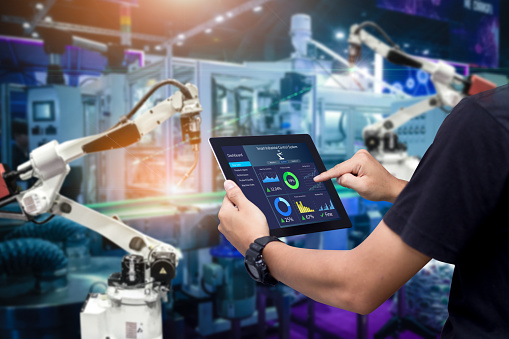Basic Ideas In Industrial Automation Using The Numerical Controlled Tools

Numerical control is the operation of machine tools by coded instructions. This means that machine operating commands in the form of symbolic codes are interpreted in such a manner that they control specific operations on a machine tool. These instructions are intended to control every phase of a project from beginning to end.
It is a control method that positions the spindle, directs the movement of the machine, and changes the rpm of the machine tool, among other operations.
When a human operator operates a machine tool by turning the handwheels in order to machine a component on a boring machine, an error will be common in the finished product.
Human errors could occur in varying degrees in cuts, measuring, and other areas. If the machine tool can substitute for any part of the manual labor of the machine operator, the component can be machined to the desired accuracy with minimal time.
The advantage of this method has made it necessary for engineers to look for easier ways to achieve speed, accuracy, and uniformity in parts productions. While automation is the answer, the numerically controlled tools help engineers to feed the machine with the information related to the component to be machined on it.
The control of a machine tool by means of recorded information on punched tape or cards is known as numerical control because the information supplied to the control system consists of a series of numbers in binary or Alphanumeric form.
Hence, it is a numerical control system meant to process and direct the intended machine.
In such a method, the machine control function done by the operator in conventional is translated into numeric instructions that can be understood by the machine control unit.
The information stored in the punched tapes or cord can be read by automatic means and converted into electrical signals, which operate the electrically controlled servo system and permits the slides of a machine tool to be driven simultaneously and at the appropriate speeds and direction.
Such that complete shape can be cut, often with a single operation, and without the need to reorient the workpiece.
Numerical control can be applied to milling machines, lathes, grinding, boring machines, flame cutters, drilling machine, etc. however, these machines should use hydrostatic lubricated slideways or rollers to reduce friction, and re-circulating ball lead screw and nut to avoid backlash problems.
The Operating Principle of the Numerically Controlled Machine Tools


With the advent of the production of sophisticated equipment and machinery, there has arisen a need to transfer instructions from man to machine through automatic devices.
The control system used with such machines requires the instructions to be encoded in a suitable language, in a particular pattern, and on a convenient medium, so that the machine can read the instructions automatically to perform the job.
The general objective behind the development of NC technology has been the reduction of cost by reducing time. This is achieved by reducing non-production time on the number of setups.
NC technology helps in reducing the workpiece handling time, tool change time, lead time, etc. with such technology, desired changes can easily be incorporated without having to change jigs, fixtures, and tools. Accuracy is improved due to the reduction of human error. NC machining is the best suited for small batch productions.
In automatic control, operations like the feeding of the stock to clamping, machining, and even inspection of the workpiece are carried out automatically.
A particular sequence is followed depending upon the requirements of the workpieces and is achieved by using cams, stops, settings, trip dogs, and other mechanical movements of the machine.
Principle of automatic control in Numerical Controlled Tools

The principle of automatic control is explained below:
- Suitable feeding arrangements like feed hoppers, strip feed rolls, etc. could be employed on the orthodox machines to make them partially automatic in respect of material handling.
- The machines used for turning operations could be made automatic in the operation of feeding and turning movement by incorporation of cams and mechanical movements, the setting of which may be made for any one of a variety of components within the capacity of the machine. Generally, one set of settings is designed to suit a given set of conditions for one particular workpiece only and to change from one job to any other necessary.
- The 3rd category of automatics includes machines designed especially for operations on a particular component and generally used for drilling and profiling operations.
- The 4th category includes transfer machining units assembled and used in conjunction with some form of conveyor or indexing work table so that the work may be automatically moved through the sequence of operations concerned.
- Before now, machines the actuation and control are based on mechanical movements have been considered automatic. However, in the recent years the concept of automatic began to change altogether due to the introduction of the automatic feedback control i.e. the tool or cutter is fed back electrically into the controlling system where it is compared with the set value, and the tool is then moved accordingly, thus; a continuous system of monitoring and corrections is used.
The Differences between Analogue and Digital Controls of Numerical Systems
Analog data are processed in their original form, while digital input data are deliberately changed to the analog form, which may be a voltage or current signal before it is processed.
After computation, the result is converted to analog form before it is used to drive the slide.
Analog control is known as positional. While digital control is known as incremental.
Analogue requires predetermining datum point. While digital requires known data points.